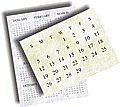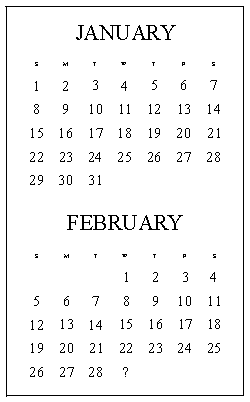 |
free plans: how to make a
Perpetual Calendar |
Basic Description
|
This is an amazing calendar that remains functional for thousands of years. We have three versions: the first is an
online version intended for online viewing and printing of selected
pages. The year-at-a-glance version uses fourteen ordinary sheets of paper and extends
from the year 1600 to 10000. Our favorite is the monthly version that spans 2800 years
and fits on 28 sheets of paper. If you used traditional
wall calendars during that period, you would need at least 30,000 sheets of paper! Don't worry these
aren't microscopic: the pages are full-size. |
| Materials |
Paper |
Background information: The idea for a perpetual calendar first occurred to me when
I realized that there are only a limited number of potential layouts for a calendar month.
It turns out that we at UNIQUEPROJECTS did not invent the perpetual calendar, but the process of figuring
it all out was enjoyable nonetheless.
A month can either
have 28, 29, 30, or 31 days. (Februarys always have 28 days unless its a leap year in which
case they have 29). Furthermore, each month can only start on one of seven days, Monday through
Sunday. This makes a total of 28 possible monthly layouts because
four (total number of possible days in a month: 28, 29,30 or 31) times seven (days on which any given month can
start) equals 28.
The only missing element at this point is which layout is linked to which month.
We accomplished this with some tricky formulas in spreadsheet software. |
|
Annual calendars are slightly different. January always has 31 days but it can
start on any of seven days of the week, depending on the year in question. That means that the
day of the week of February first is dependent
on the day of the week of the January first. For example, if January starts on a Sunday,
February must start on a Wednesday. February, however, can either
be 28 days or 29 days depending on whether the year in question is a leap year;
see the calendar to the right. The remaining
months of the year have fixed amounts of days. Therefore, January can start
on any of seven days when it is a non-leap year and it can start on any of seven days when
it is a leap year: this creates 14 yearly possibilities.
With this established, the only requirement is to determine which years were leap years
and on which day January started for a given year.
|
 |
A year is not an arbitrary period
of time, it is an astronomic reality; it represents the time it takes for the earth
to orbit around the sun. A good calendar therefore, needs to match this period
of time. It takes 365.242 days for the earth to complete the trip.
Instead of adding .242 of a day (5 hours 48 minutes and 30 seconds) to a 365-day year
the leap-year system was devised. Every four years an extra day was added to the
365 days in the regular calendar. This system is relatively accurate,
but .242 is not exactly the .250 of a day that it needs to be for the leap-day to work perfectly.
Over the centuries the .008 (.250 minus .242) of a day or 11 minutes 30 seconds began to
add up. The continuing accumulation came to an end in October 1582 when Pope Gregory XIII stated that 10 days were to be removed from the calendar that month. This made for a
bizarre month. You can imagine what people's schedule's
looked like that month.
Pope Gregory XIII, for whom the modern calendar is named after (Gregorian), also established a system
to prevent the accumulation from beginning all over again.
Every four years divisible by four would continue to be a leap year, but years divisible
by 100 would not unless they are also divisible by 400. So the year 2000 was one of these
special years that comes once every four centuries: divisible by 100 but also divisible by 400--a
non-leap year. This new system is far superior to
the outdated one it replaced, but its still
not 100% perfect. When you do the math, there still is a minuscule accumulation and perhaps in thousands
of years another day will have to be stricken from the calendar or perhaps a leap year bypassed.
With your wall calendar printed, you may want to make a wall holder for it.
|




